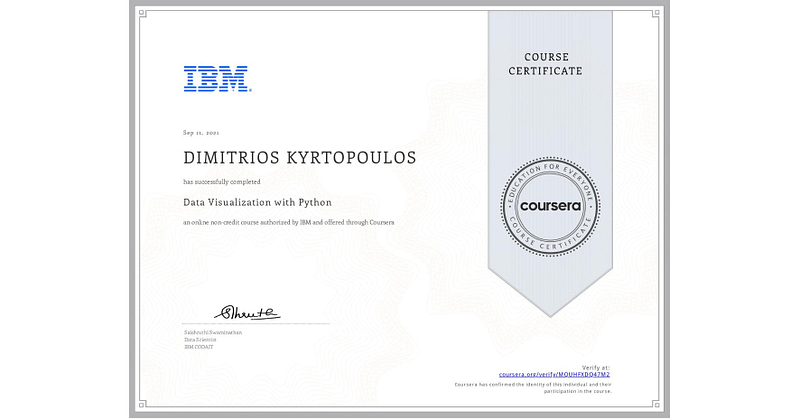IBM Data Visualization with Python
Instructor
About this Course
“A picture is worth a thousand words”. We are all familiar with this expression. It especially applies when trying to explain the insight obtained from the analysis of increasingly large datasets. Data visualization plays an essential role in the representation of both small and large-scale data.
One of the key skills of a data scientist is the ability to tell a compelling story, visualizing data and findings in an approachable and stimulating way. Learning how to leverage a software tool to visualize data will also enable you to extract information, better understand the data, and make more effective decisions. The main goal of this Data Visualization with Python course is to teach you how to take data that at first glance has little meaning and present that data in a form that makes sense to people. Various techniques have been developed for presenting data visually but in this course, we will be using several data visualization libraries in Python, namely Matplotlib, Seaborn, and Folium.
What you will learn
Describe the importance of data visualization.
Relate the history of Matplotlib and its architecture.
Apply Matplotlib to create plots using Jupyter notebooks.
Discover how to read CSV files into a Pandas DataFrame; process and manipulate the data in the DataFrame; and generate line plots using Matplotlib.
Skills you will gain
Python Programming
Data Virtualization
Plotly
Matplotlib
Data Visualization (DataViz)
Syllabus
Week 1: Introduction to Data Visualization Tools
In this module, you will learn about data visualization and some of the best practices to keep in mind when creating plots and visuals. You will also learn about the history and the architecture of Matplotlib and learn about basic plotting with Matplotlib. In addition, you will learn about the dataset on immigration to Canada, which will be used extensively throughout the course. Finally, you will briefly learn how to read csv files into a pandas dataframe and process and manipulate the data in the dataframe, and how to generate line plots using Matplotlib.
Week 2: Basic and Specialized Visualization Tools
In this module, you learn about area plots and how to create them with Matplotlib, histograms and how to create them with Matplotlib, bar charts, and how to create them with Matplotlib, pie charts, and how to create them with Matplotlib, box plots and how to create them with Matplotlib, and scatter plots and bubble plots and how to create them with Matplotlib.
Week 3: Advanced Visualizations and Geospatial Data
In this module, you will learn about advanced visualization tools such as waffle charts and word clouds and how to create them. You will also learn about seaborn, which is another visualization library, and how to use it to generate attractive regression plots. In addition, you will learn about Folium, which is another visualization library, designed especially for visualizing geospatial data. Finally, you will learn how to use Folium to create maps of different regions of the world and how to superimpose markers on top of a map, and how to create choropleth maps.
Week 4: Creating Dashboards with Plotly and Dash
In this module you will get started with dashboard creation using the Plotly library. You will create a dashboard with a theme `US Domestic Airline Flights Performance`. You will do this using a US airline reporting carrier on-time performance dataset, Plotly, and Dash concepts learned throughout the course. Hands-on labs will follow each concept to make you comfortable with using the library. Reading lists will reference additional resources to learn more about the concepts covered.
Week 5: Final Project
This module of the course is centered on completing your final lab assignment. In the assignment you will function as a data analyst where you have been given a task to monitor and report US domestic airline flights performance. The goal is to analyze the performance of the reporting airline to improve fight reliability thereby improving customer reliability. Once you are done with your work, you will submit your assignment for peer review. After that, you will be asked to review work submitted by your peers.

